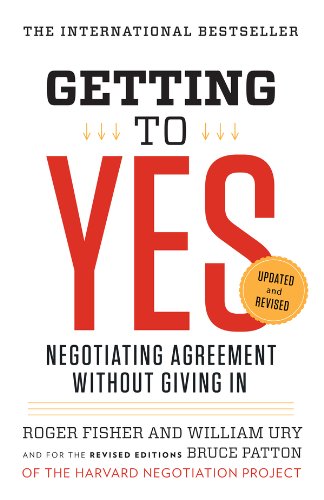

This article is an excerpt from the Shortform summary of "Getting to Yes" by Roger Fisher and William Ury. Shortform has the world's best summaries of books you should be reading.
Like this article? Sign up for a free trial here .
Negotiating is a skill you use daily. How can you get others to give you what you want and need? Everyone wants to know how to get to yes.
We’ll cover the key skills and strategies to figure out how to get to yes at work and at home, every day.
Why Get to Yes?
In our daily lives, we all negotiate with others for things we want, whether the context is business or personal. For instance, at work, we may negotiate a contract with a supplier, while at home we may negotiate with siblings over the division of family heirlooms or with a spouse over where to go on vacation.
In Getting to Yes, authors Roger Fisher and William Ury point out that the number of situations requiring negotiation is increasing. Organizational structures are less hierarchical than they used to be and people expect to have a say in decisions that affect them rather than being dictated to by a boss. This requires negotiation. Further, it requires knowing how to get to yes.
How to Get to Yes: Skills and Strategies
The process of principled negotiation can help you learn how to get to yes. Besides the method of principled negotiation, key skills include:
- Determine your best available alternative to a negotiated agreement (BATNA). The purpose of negotiating is to get better results than you’d get without negotiating. So when negotiating, you need to know your best alternative to negotiation in order to know whether to accept an agreement. Measure any proposed agreement against your best alternative or BATNA. It will protect you from accepting a bad agreement, as well as from rejecting a good agreement.
- Defuse emotions that hinder discussion. Talk openly with the other side about their emotions. Talk about your own emotions too. Acknowledge the emotions as legitimate. With emotions acknowledged, negotiations can be less reactive and more proactive; people can more easily focus on the substantive issues with emotions out of the way. Also, allow the other side to vent. Don’t react to an emotional outburst and don’t interrupt — just sit and listen. Then you can move on.
- Build a positive relationship with the other side. Before negotiations begin, get to know the people on the other side personally. It’s easier to negotiate with someone you know than with a stranger. Meet informally, learn each others’ likes and dislikes and take the time to chat when you run into people on the other side. Or use Ben Franklin’s technique — he liked to ask an opponent if he could borrow a specific book. Their common interest in the book made them more comfortable with each other and gave them something innocuous to chat about.
- Counter dirty tricks by redirecting the discussion. Positional bargainers may use a variety of strong-arm tactics in an effort to get you to succumb to their position, including lies, pressure tactics, and psychological tricks. The only effective way to counter these tactics is to use the techniques of principled negotiation to establish how you’re going to negotiate (the rules of the game). Follow these steps: recognize the tactic, call attention to it, and question its validity as a tactic. Use the tactic as the basis for discussing how to negotiate constructively.
- Negotiate effectively when there are differences around gender, ethnicity, or culture. Be aware of differing beliefs and customs, but don’t stereotype. Individuals’ attitudes and characteristics may differ from those of their group (for instance, not all Japanese prefer indirect communication). This applies to genders as well. It’s insulting to make assumptions based on the group to which someone belongs. Question your assumptions and be open to learning that others are different from what you expected. Everyone has special interests and qualities that don’t fit any mold.
- Reach a successful agreement when the other side is more powerful. While wealth and connections enhance negotiating power, the power of each side also depends on negotiating skill and the strength of their alternative. If you have a stronger alternative — for instance, the ability to get a better price elsewhere — you can walk away from an agreement, which gives you leverage. The stronger your BATNA (best alternative to a negotiated agreement), the greater your power. Other power enhancers include a good working relationship, listening skills, and ability to identify the other side’s interests and develop create mutually satisfying options.
All of these skills and strategies will help you figure out how to get to yes. To sum up, in contrast to adversarial bargaining, practicing principled negotiation allows you to treat people with empathy, work toward a wise agreement that’s fair for both parties, negotiate efficiently without deliberate delays, and end the process on a positive note that bodes well for your future relationship. This is how to get to yes.
———End of Preview———

Like what you just read? Read the rest of the world's best summary of "Getting to Yes" at Shortform . Learn the book's critical concepts in 20 minutes or less .
Here's what you'll find in our full Getting to yes summary :
- Why the standard way of negotiating is completely wrong
- How to find outcomes that are wins for both sides
- How to protect yourself against aggressive negotiators






